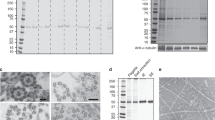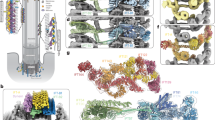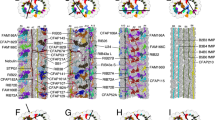Abstract
Sensory cilia are assembled and maintained by kinesin-2-dependent intraflagellar transport (IFT). We investigated whether two Caenorhabditis elegans α - and β-tubulin isotypes, identified through mutants that lack their cilium distal segments, are delivered to their assembly sites by IFT. Mutations in conserved residues in both tubulins destabilize distal singlet microtubules. One isotype, TBB-4, assembles into microtubules at the tips of the axoneme core and distal segments, where the microtubule tip tracker EB1 is found, and localizes all along the cilium, whereas the other, TBA-5, concentrates in distal singlets. IFT assays, fluorescence recovery after photobleaching analysis and modelling indicate that the continual transport of sub-stoichiometric numbers of these tubulin subunits by the IFT machinery can maintain sensory cilia at their steady-state length.
This is a preview of subscription content, access via your institution
Access options
Subscribe to this journal
Receive 12 print issues and online access
$209.00 per year
only $17.42 per issue
Buy this article
- Purchase on Springer Link
- Instant access to full article PDF
Prices may be subject to local taxes which are calculated during checkout





Similar content being viewed by others
References
Goetz, S. C. & Anderson, K. V. The primary cilium: a signalling centre during vertebrate development. Nat. Rev. Genet. 11, 331–344 (2010).
Insinna, C., Pathak, N., Perkins, B., Drummond, I. & Besharse, J. C. The homodimeric kinesin, Kif17, is essential for vertebrate photoreceptor sensory outer segment development. Dev. Biol. 316, 160–170 (2008).
Mesland, D. A., Hoffman, J. L., Caligor, E. & Goodenough, U. W. Flagellar tip activation stimulated by membrane adhesions in Chlamydomonas gametes. J. Cell Biol. 84, 599–617 (1980).
Moran, D. T., Rowley, J. C. 3rd, Jafek, B. W. & Lovell, M. A. The fine structure of the olfactory mucosa in man. J. Neurocytol. 11, 721–746 (1982).
Perkins, L. A., Hedgecock, E. M., Thomson, J. N. & Culotti, J. G. Mutantsensory cilia in the nematode Caenorhabditis elegans. Dev. Biol. 117, 456–487 (1986).
Wang, Q., Pan, J. & Snell, W. J. Intraflagellar transport particles participatedirectly in cilium-generated signaling in Chlamydomonas. Cell 125, 549–562 (2006).
Cole, D. G. et al. Novel heterotrimeric kinesin-related protein purified from sea urchin eggs. Nature 366, 268–270 (1993).
Cole, D. G. et al. Chlamydomonas kinesin-II-dependent intraflagellar transport (IFT): IFT particles contain proteins required for ciliary assembly in Caenorhabditis elegans sensory neurons. J. Cell Biol. 141, 993–1008 (1998).
Kozminski, K. G., Johnson, K. A., Forscher, P. & Rosenbaum, J. L. A motility in the eukaryotic flagellum unrelated to flagellar beating. Proc. Natl Acad. Sci. USA 90, 5519–5523 (1993).
Shakir, M. A., Fukushige, T., Yasuda, H., Miwa, J. & Siddiqui, S. S. C. elegans osm-3 gene mediating osmotic avoidance behaviour encodes a kinesin-like protein. Neuroreport 4, 891–894 (1993).
Pedersen, L. B. & Rosenbaum, J. L. Intraflagellar transport (IFT) role in ciliary assembly, resorption and signalling. Curr. Top. Dev. Biol. 85, 23–61 (2008).
Hao, L & Scholey, J. M. Intraflagellar transport at a glance. J. Cell Sci. 122, 889–892 (2009).
Lucker, B. F., Miller, M. S., Dziedzic, S. A., Blackmarr, P. T. & Cole, D. G. Direct interactions of intraflagellar transport complex B proteins IFT88, IFT52, and IFT46. J. Biol. Chem. 285, 21508–21518 (2010).
Pigino, G. et al. Electron-tomographic analysis of intraflagellar transport particle trains in situ. J. Cell Biol. 187, 135–148 (2009).
Johnson, K. A. & Rosenbaum, J. L. Polarity of flagellar assembly in Chlamydomonas. J. Cell Biol. 119, 1605–1611 (1992).
Marshall, W. F. & Rosenbaum, J. L. Intraflagellar transport balances continuous turnover of outer doublet microtubules: implications for flagellar length control. J. Cell Biol. 155, 405–414 (2001).
Engel, B. D., Ludington, W. B. & Marshall, W. F. Intraflagellar transport particle size scales inversely with flagellar length: revisiting the balance-point length control model. J. Cell Biol. 187, 81–89 (2009).
Shah, J. V. & Cleveland, D. W. Slow axonal transport: fast motors in the slow lane. Curr. Opin. Cell Biol. 14, 58–62 (2002).
Ou, G., Blacque, O. E., Snow, J. J., Leroux, M. R. & Scholey, J. M. Functional coordination of intraflagellar transport motors. Nature 436, 583–587 (2005).
Pan, X. et al. Mechanism of transport of IFT particles in C. elegans cilia by the concerted action of kinesin-II and OSM-3 motors. J. Cell Biol. 174, 1035–1045 (2006).
Snow, J. J. et al. Two anterograde intraflagellar transport motors cooperate to build sensory cilia on C. elegans neurons. Nat. Cell Biol. 6, 1109–1113 (2004).
Burghoorn, J. et al. Mutation of the MAP kinase DYF-5 affects docking and undocking of kinesin-2 motors and reduces their speed in the cilia of Caenorhabditis elegans. Proc. Natl Acad. Sci. USA 104, 7157–7162 (2007).
Jenkins, P. M. et al. Ciliary targeting of olfactory CNG channels requires the CNGB1b subunit and the kinesin-2 motor protein, KIF17. Curr. Biol. 16, 1211–1216 (2006).
Dishinger, J. F. et al. Ciliary entry of the kinesin-2 motor KIF17 is regulated by importin-β2 and RanGTP. Nat. Cell Biol. 12, 703–710 (2010).
Inglis, P. N., Ou, G., Leroux, M. R. & Scholey, J. M. The sensory cilia of Caenorhabditis elegans. WormBook 1–22 (2007).
Fan, Z. C. et al. Chlamydomonas IFT70/CrDYF-1 is a core component of IFT particle complex B and is required for flagellar assembly. Mol. Biol. Cell 21, 2696–2706 (2010).
Ou, G. et al. Sensory ciliogenesis in Caenorhabditis elegans: assignment of IFT components into distinct modules based on transport and phenotypic profiles. Mol. Biol. Cell 18, 1554–1569 (2007).
Kobayashi, T., Gengyo-Ando, K., Ishihara, T., Katsura, I. & Mitani, S. IFT-81 and IFT-74 are required for intraflagellar transport in C. elegans. Genes Cells 12, 593–602 (2007).
Bell, L. R., Stone, S., Yochem, J., Shaw, J. E. & Herman, R. K. The molecular identities of the Caenorhabditis elegans intraflagellar transport genes dyf-6, daf-10 and osm-1. Genetics 173, 1275–1286 (2006).
Hou, Y. et al. Functional analysis of an individual IFT protein: IFT46 is required for transport of outer dynein arms into flagella. J. Cell Biol. 176, 653–665 (2007).
Hurd, D. D., Miller, R. M., Nunez, L. & Portman, D. S. Specific α- and β-tubulin isotypes optimize the functions of sensory cilia in Caenorhabditis elegans. Genetics 185, 883–896 (2010).
Wright, A. J. & Hunter, C. P. Mutations in a β-tubulin disrupt spindle orientation and microtubule dynamics in the early Caenorhabditis elegans embryo. Mol. Biol. Cell 14, 4512–4525 (2003).
Lowe, J., Li, H., Downing, K. H. & Nogales, E. Refined structure of αβ-tubulin at 3.5 A resolution. J. Mol. Biol. 313, 1045–1057 (2001).
Uchimura, S., Oguchi, Y., Hachikubo, Y., Ishiwata, S. & Muto, E. Key residues on microtubule responsible for activation of kinesin ATPase. EMBO J. 29, 1167–1175 (2010).
Efimenko, E. et al. Analysis of xbx genes in C. elegans. Development 132, 1923–1934 (2005).
Schroder, J. M., Schneider, L., Christensen, S. T. & Pedersen, L. B. EB1 is required for primary cilia assembly in fibroblasts. Curr. Biol. 17, 1134–1139 (2007).
Yu, S., Avery, L., Baude, E. & Garbers, D. L. Guanylyl cyclase expression in specific sensory neurons: a new family of chemosensory receptors. Proc. Natl Acad. Sci. USA 94, 3384–3387 (1997).
Qin, H. et al. Intraflagellar transport is required for the vectorial movement of TRPV channels in the ciliary membrane. Curr. Biol. 15, 1695–1699 (2005).
Jaglin, X. H. et al. Mutations in the β-tubulin gene TUBB2B result in asymmetrical polymicrogyria. Nat. Genet. 41, 746–752 (2009).
Tischfield, M. A. et al. Human TUBB3 mutations perturb microtubule dynamics, kinesin interactions, and axon guidance. Cell 140, 74–87 (2010).
Nielsen, M. G., Turner, F. R., Hutchens, J. A. & Raff, E. C. Axoneme-specific β-tubulin specialization: a conserved C-terminal motif specifies the central pair. Curr. Biol. 11, 529–533 (2001).
Deane, J. A., Cole, D. G., Seeley, E. S., Diener, D. R. & Rosenbaum, J. L. Localization of intraflagellar transport protein IFT52 identifies basal body transitional fibers as the docking site for IFT particles. Curr. Biol. 11, 1586–1590 (2001).
Brenner, S. The genetics of Caenorhabditis elegans. Genetics 77, 71–94 (1974).
Wicks, S. R., Yeh, R. T., Gish, W. R., Waterston, R. H. & Plasterk, R. H. Rapid gene mapping in Caenorhabditis elegans using a high density polymorphism map. Nat. Genet. 28, 160–164 (2001).
Yoshimura, S., Murray, J. I., Lu, Y., Waterston, R. H. & Shaham, S. mls-2 and vab-3 control glia development, hlh-17/Olig expression and glia-dependent neurite extension in C. elegans. Development 135, 2263–2275 (2008).
Hao, L., Acar, S., Evans, J., Ou, G. & Scholey, J. M. Analysis of intraflagellar transport in C. elegans sensory cilia. Methods Cell Biol. 93, 235–266 (2009).
James, P., Halladay, J. & Craig, E. A. Genomic libraries and a host strain designed for highly efficient two-hybrid selection in yeast. Genetics 144, 1425–1436 (1996).
Signor, D., Wedaman, K. P., Rose, L. S. & Scholey, J. M. Two heteromeric kinesin complexes in chemosensory neurons and sensory cilia of Caenorhabditis elegans. Mol. Biol. Cell 10, 345–360 (1999).
Larkin, M. A. et al. Clustal W and Clustal X version 2.0. Bioinformatics 23, 2947–2948 (2007).
Cheerambathur, D. K., Brust-Mascher, I., Civelekoglu-Scholey, G. & Scholey, J. M. Dynamic partitioning of mitotic kinesin-5 cross-linkers between microtubule-bound and freely diffusing states. J. Cell Biol. 182, 429–436 (2008).
Mullineaux, C. W., Nenninger, A., Ray, N. & Robinson, C. Diffusion of green fluorescent protein in three cell environments in Escherichia coli. J. Bacteriol. 188, 3442–3448 (2006).
Acknowledgements
We thank X. Zhang (Heyer Laboratory), A. Desai and G. Ou for valuable discussion; M. Shohei (Tokyo Women’s Medical University, School of Medicine, Tokyo, Japan) for the deletion mutants, tm2355, tm2394 and tm4200; the Caenorhabditis Genetics Center (funded by the NIH National Center for Research Resources) for strains; and Y. Kohara, Center for Genetic Resource Information, National Institute of Genetics, Japan for EST clones. This work was supported by NIH grant nos GM50718 to J.M.S. and R01NS064273 to S.S.
Author information
Authors and Affiliations
Contributions
J.M.S is the principal investigator of the grant and laboratory that support this IFT project. L.H. and J.M.S. designed the experiments and drafted the manuscript. J.M.S. wrote the manuscript. L.H. carried out most of the experiments. M.T. characterized the qj14 mutant by crossing all of the used IFT markers into it, made the TBB-4::YFP transgenic worms and carried out the EBP-2 experiments. I.B-M. implemented the stochastic tubulin transport and dynamics model and the in silico FRAP model and analysed the results, and helped with the FRAP experiment and transport assay of TBB-4::YFP and analysis of the results. G.C-S. designed and wrote the stochastic tubulin transport and dynamics model and the in silico FRAP model scripts. Y.L. and S.S. carried out the electron microscopy studies and analysed the results. S.A. and B.P. carried out the Y2H assays. All of the authors read the manuscript.
Corresponding author
Ethics declarations
Competing interests
The authors declare no competing financial interests.
Supplementary information
Supplementary Information
Supplementary Information (PDF 1294 kb)
Supplementary Information
Supplementary Table 1 (XLS 36 kb)
Supplementary Information
Supplementary Table 2 (XLS 47 kb)
Supplementary Information
Supplementary Table 3 (XLS 38 kb)
Supplementary Information
Supplementary Table 4 (XLS 27 kb)
Rights and permissions
About this article
Cite this article
Hao, L., Thein, M., Brust-Mascher, I. et al. Intraflagellar transport delivers tubulin isotypes to sensory cilium middle and distal segments. Nat Cell Biol 13, 790–798 (2011). https://doi.org/10.1038/ncb2268
Received:
Accepted:
Published:
Issue Date:
DOI: https://doi.org/10.1038/ncb2268
This article is cited by
-
Regulation of ciliary homeostasis by intraflagellar transport-independent kinesins
Cell Death & Disease (2024)
-
Transport and barrier mechanisms that regulate ciliary compartmentalization and ciliopathies
Nature Reviews Nephrology (2024)
-
Reconstitution reveals motor activation for intraflagellar transport
Nature (2018)
-
The rise and fall of basal bodies in the nematode Caenorhabditis elegans
Cilia (2017)
-
Axonemal Lumen Dominates Cytosolic Protein Diffusion inside the Primary Cilium
Scientific Reports (2017)



